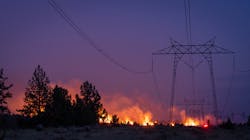Argonne Climate Model Helps PG&E Plan for Wildfire Impacts
Pacific Gas and Electric Co. (PG&E) is sponsoring research at the U.S. Department of Energy's (DOE's) Argonne National Laboratory to produce local climate-change models. This action is part of a wider effort on the PG&E's part to protect the safety of its customers and support the reliability of its electric grid.
The climate is changing, and these changes are impacting critical infrastructure in the United States. Patterns of floods, fires, heatwaves, and hurricanes are shifting, and forward-thinking companies are taking steps to analyze current and future climate-related risks so they can improve the resilience of their infrastructure and keep critical services up and running.
Most climate models provide information on how climate will change over a large area, typically 100 km2 or more. Although this can help countries prepare for climate change, it is not very useful for planning on a regional scale. These models are also difficult for companies to use to determine how climate change could impact their infrastructure or affect their operations, customers, and their bottom line.
In order to address this challenge, scientists at Argonne developed a detailed climate model that projects future climate in a 12-km grid across the entire United States. Harnessing the power of Argonne’s supercomputers, they made the most accurate global climate models work over a much smaller scale.
"Our goal is to translate this huge data set we created into useable data products so that others can use it to estimate their impacts and risk," said Rao Kotamarthi, chief scientist and head of the Department of Atmospheric Science and Climate Research at Argonne.
Argonne is providing data from its climate model for things that impact fire risk, such as high wind speeds, low humidity, and soil moisture, which the PG&E will combine with existing science on how climate change will affect heat and precipitation. These combined data sets will be integrated into the PG&E’s own climate models so it can make more informed decisions to safeguard customers, communities, and the grid.
"Argonne’s research will really advance our knowledge of how weather might affect our assets and operations in the future," said Debbie Powell, interim head of electric operations at the PG&E. "It will help us determine where our most vulnerable electric assets are so we can continue to prepare for climate change by strengthening our infrastructure."
